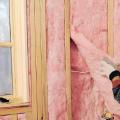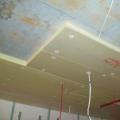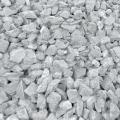Review of simple house designs made from foam concrete blocks
When choosing a material for the external and internal walls of residential buildings, foam concrete blocks are considered as a budget option. Their performance and operational characteristics cannot be considered universal, but if all features are taken into account at the preparation stage, you can quickly obtain a reliable, warm and non-shrinking building. Prices for the construction of such houses are 14,000 rubles/m2 for a box and from 19,000 for turnkey construction. The dimensions and weight of the blocks allow you to carry out the masonry yourself, the same applies to most other stages, but the design and preparation of the reinforcement scheme is entrusted to specialists.
Foam concrete is valued for its lightness, fire safety, good thermal insulation properties and ability to absorb noise, the absence of deformation and shrinkage processes. The main advantages include the reasonable price of the products themselves, the simplicity of their laying and finishing. With the correct calculation of the walls and the exclusion of cold bridges, there is no need for additional insulation. If the latter is necessary (due to living in a harsh climatic zone, for example), the thickness of the outer layer of the heat insulator will be minimal. The material allows the walls to breathe, there are no toxins in its composition, and as a result, its use provides a good microclimate in the house.
Features taken into account during the design include low tensile strength, the need for protection from external moisture and good permeability due to the cellular structure. Foam concrete blocks are optimal for low-rise construction; to ensure reliable operation, the structures are reinforced: longitudinally through 2-3 rows and in areas with high loads: openings, a belt for attaching the mauerlat or installing floor beams. Durability is 50-70 years, performance characteristics largely depend on the quality of production. The last factor is considered the main disadvantage; checking the certificate when purchasing material is a mandatory step.
Brief description of projects

A simple house made of foam blocks with an attic and a garage; if desired, a glazed terrace can be added to the scheme. The main advantage is compactness: on a limited rectangular plot of 68 m2 there is a spacious living room, kitchen, 2 bedrooms, separate bathroom and toilet. The attached 3x7 garage is designed to park one car, and the attic space above is used as a utility room. Natural lighting on the attic floor is provided by sloping windows in the pitched roof and vertical windows on the pediment. The house is designed for permanent residence of a family of 3-4 people.

Another traditional project of a two-story house made of blocks with separated areas for joint and individual spending time. On the ground floor there is a spacious living room with a fireplace combined with a dining room, a kitchen with a multifaceted glazed bay window, and utility rooms. The attic includes three separate bedrooms (if desired, any of them can be converted into an office or studio) and a bathroom; there is no garage. The interior is designed in a classic style; its visual appeal is enhanced by protruding windows (the total glazing area is large) and a wide single-flight staircase in the spacious hall.

The project of a cottage made of foam blocks with an attached garage and attic, the total usable area is 140 m2. The form is complex, it includes protruding bay windows and a multi-sloping roof. On the ground floor there is a bathroom, kitchen, dining room and spacious living room. A two-flight staircase leads to the second floor; this area is intended for relaxation; it contains 2 bedrooms and a bathroom. The cottage can be used both as a summer country house and for permanent residence; the garage is designed to accommodate 1 car.
How and on what can you save?
An economy class house made of foam blocks costs the future owner 20-30% cheaper compared to a similar building made of brick. The design includes a stable monolithic foundation (the type and depth of the foundation depend on the soil parameters), a reinforced box, floor partitions and a rafter system. To reduce overall costs it is recommended:
1. Take into account all operating conditions at the stage of preparing the house project, draw up a work schedule, calculate the exact amount of building materials and purchase them in bulk.
2. If possible, replace concrete floors with wooden beams. Compared to factory-made reinforced concrete slabs, they are inexpensive, but their admissibility is determined by calculations.
3. Use foam blocks for masonry with high precision geometric shapes and sizes, otherwise glue consumption and finishing requirements increase. The quality of the products is checked before purchase: when placed next to each other, they should not form gaps or become colored, the cells have a closed structure and spherical shape, their diameter does not exceed 1-3 mm, the color on the surface and on the break is the same and uniform, there is no yellowness. To build load-bearing walls, you need a grade of at least D600, the minimum permissible thickness is 300 mm, but you can save on internal partitions - 100 mm of masonry is enough.

4. Give up the basement.
5. Replace the second floor with an attic located above it. The same solution is offered if it is necessary to obtain a larger number of premises during construction in a limited space. There is an unspoken rule: with the same total area, the design of a one-story house is less justified than a two-story one; the budget is considered to be recouped when it exceeds more than 100 m2. But at the same time, we must not forget about the restriction on the number of storeys - the permissible maximum is 3; ignoring this rule leads to an unjustified increase in costs for armored belts and laying the foundation.
6. If you have a limited budget, avoid complex architectural forms - terraces, bay windows, balconies, turrets. The same rule applies to roofing systems; the simplest and most affordable option is a gable roof.
7. Carry out the work on your own. The cost of a turnkey finished house (but without interior finishing and wiring) when contacting construction companies is at least 19,000 rubles per 1 m2; independent masonry and cladding reduces costs by a third.

Factors to consider during design
Houses and cottages are built according to a standard or individual plan. The finished project is inexpensive (in the range of 20,000-30,000 rubles), but it does not take into account all the conditions of construction and operation. Agreeing on special requirements takes a lot of time; the preparation of such documentation takes at least 1.5 months. In any case, the following is taken into account:
1. Seismic activity of the region; when construction is carried out in the zone of movement of tectonic plates, the requirements for the stability of the foundation and prices for masonry increase; in case of high risks, foam blocks are replaced with other building materials.
2. Climatic conditions: average annual precipitation, humidity and air temperature. These parameters are taken into account when calculating the thickness of external walls, when determining the total weight loads and choosing the material and finishing method. When building in regions with an average daily air temperature in winter below -20°C, roof insulation must be provided.

3. Geological parameters of the site: type and degree of soil homogeneity, depth of groundwater, level of freezing. The initial data are the results of an analysis of the state of the soil, ideally carried out during the period of maximum precipitation and rise in ground moisture - in spring or autumn.
If there is a risk of flooding, it is better to build a house made of foam blocks without a basement or underground floor; the costs of waterproofing and drainage will be unreasonably high.
4. Construction budget. With limited funds, the simplest project is chosen, without protrusions and. The fewer complex forms are laid, the more reliable the house. This is explained by the low resistance of the blocks to tensile loads; only specialists can achieve their uniform distribution with asymmetrical arrangement of structures.
5. The need for energy saving. One of the main advantages is the possibility of constructing residential buildings without additional insulation, even with single-layer masonry. In practice, the amount of energy consumption is influenced by many factors: from the glass area to the location of the rooms. If the main priority is energy efficiency, then the project includes smaller windows and all outbuildings are placed on the north side. If the emphasis is on external attractiveness, protruding glazed bay windows, verandas and balconies are added to the house plan; accordingly, the costs of turnkey construction and heating of buildings increase.
 Construction materials and list of works
Construction materials and list of works Proper insulation of a wooden ceiling in a private house
Proper insulation of a wooden ceiling in a private house What types of crushed stone are there?
What types of crushed stone are there?